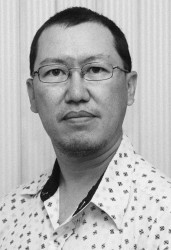By Rae Wiltshire
Great works of art always inspire other great works of art. Don’t agree? Read a few Batman Comics. Some people like simplicity and some people like complexity, but it all comes down to one thing: Is your work a force to be reckoned with?
Most artists don’t have the gall to say their work is something that would endure the test of time and why should they? The fear of failure lingers in their minds. Those who dare declare themselves a master of their time should be admired.

The medium taking centre stage here is photography and the photographer whose work is being assessed is Michael Lam.
A good photograph should send the imagination soaring. With the world getting busier everyday daydreaming is a luxury and assessing the works of fellow daydreamers seems impossible.
Michael is a humble photographer who seems not to know the power of his images and the visual magnitude they create.
His humility is an admirable quality given his meticulous compositions of artistic photographs.
Michael Lam started off as a biologist, but in this interview, he talks to The Scene about his photography:
Q: What does photography mean to you?
A: Photography is an artistic outlet for me; a way to express the way I see things. There is not always an underlying message in a photograph, but if it affects the viewer in any way then it is a good photo for me.
Q: Why did you choose invest so much time in photography?
A: I had access to a camera, and my good friend Nikhil Ramkarran was encouraging me to take it more seriously than I was at the time (some 6 years ago or more). Now, if I want the photos that I share to be taken seriously as art and not just as a snapshot, then I have to invest what time I can into the endeavour, and utilise that time well.
Q: What drives you to create?
A: The drive is internal, not of external origin. I don’t create to please someone else. Some scenes compel you to stop and think about [them] and to capture [them] in some way. For me, that way is through a photograph. The drive is not always there. Like other artists there are times when the motivation is not there, but for me stopping is not an option. I have to keep my camera with me, ready for that next photo that might just be there.
Q: You said that before you mainly focused on the technical side of photography and less on the artistic side, describe this transition for me.
A: In the beginning, it was a fascination with the camera: what the different modes were for; what can I change to alter the way the photograph comes out. As I became more familiar with the camera, less time was spent on the how to take a photograph and more on what to take a photograph of.
Q: Why was there a sudden switch?
A: I think the change was gradual. I still have many favourites from the beginning, so it was not all about the gear. But at some point it began to become less about what I had in my hands and more about what was in front of me.
Q: What is the most vital piece of advice you can give to young photographers?
Following on your previous two questions I have to give two bits of advice: know your gear, learn what it can and cannot do; then know what it is you want the photograph to express, that alters how you take it and how you process it.
Q: How do you want to be remembered?
A: It is not important that I be remembered. I don’t need a legacy. My desire is for photographers locally to keep working to express themselves artistically, and help others along the way. We do not live in a vacuum, and we cannot produce art in a vacuum. If any of my photographs survive my lifetime that would be intriguing. At the moment my main work is in my black and white seascapes. Will those be remembered? Who knows? Unlikely, but if any other young local photographer learns even one thing from them then that is even better.
Q: Can you list some artists’ work and talk about the effect it had on you?
A: That can be a long list. Growing up the name Bobby Fernandes has always been associated with photography (especially locally), and I’ve been fortunate to know him and many of his works over the years, and he has been an inspiration to me in more ways than one. Although I don’t photograph people often, I’ve always been awed by the works of photojournalist Steve McCurry. And although my own photography does not resemble either of these gentlemen’s, I continue to look at and learn from their works. If you’ve seen my more recent works, you’ll have noted the strong presence of black and white landscapes and seascapes. There are primarily three photographers whose work have influenced me strongly with respect to this. Ansel Adams’s landscape photography of the American north-west has always struck me as amazing. The seascapes of Hiroshi Sugimoto have made me look toward our own shores for photographic opportunities. The long exposure work of Darren Moore has caused me to stop and just stare into his haunting yet beautiful photos. I may never produce work a fraction as good as any of these artists, but I shall keep trying.
Q: Many artists have a particular style and they are prone to subjectivity, what’s your favourite type of photography?
A: My favourite type currently is landscape or seascape photography, heavily influenced by some great photographers as I have mentioned. [But] that does not preclude me from trying other types. I’ve tried many in my short journey so far, and there is still a lot to learn.
Q: How important is to study the history of photography and those that have come before us?
Is it vital to know the history? Probably not, but it is important to learn at least some of it. I think it is important to know the past, to learn from it so that we may, ourselves, do better, or at least try to.
Q: If you died and realised cameras were only allowed in hell would you go to heaven or move in with the devil?
A: Heaven probably has no use for cameras, and Hell might be very interesting photographically, I’ve some time left here on earth, when I cross over I’ll decide (smile).








